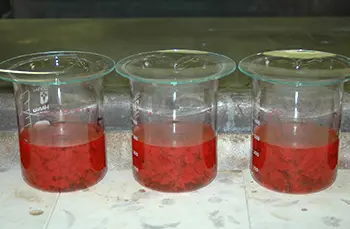Chemical Analysis
Wet Chemical Analysis
The wet chemical analysis uses the procedure to decompose a sample with a reagent such as acids to dissolve in a solvent and identifies and quantifies the targeted elements using various measurement methods. Separation and isolation of the sample is performed if needed.
The wet chemical analysis utilizes the stoichiometric method such as the gravimetric method and the volumetric method ensuring the precise and accurate (quantitative) chemical analysis of the sample. This method is widely used in determining the major components with high accuracy and precision and in checking the accuracy of standard specimens and reagents for instrument analysis.
The wet chemical analysis can be divided in two types of analysis, the qualitative analysis to identify the elements and the quantitative analysis to determine the quantity.
There are several methods in the quantitative analysis.
JFE-TEC performs the analysis with high accuracy and precision of various materials including not only steel-related samples but also non-ferrous metals and ceramics.

Sophisticated techniques for the sample preparation by dissolving, separating and fractionating the sample and for the measurement of the elements are required for accurate determination of the elements.
Advantages of Wet Chemical Analysis
Accurate Quantitative Analysis
Determination of quantities in the wet chemical analysis uses the method based on stoichiometry such as the gravimetric method and the volumetric method ensuring the accurate absolute quantity. This quantitative analysis method is widely used in determining the major components with high accuracy and precision and in checking the accuracy of standard specimen and reagents for instrument analysis.
JFE-TEC performs the analysis with high accuracy and precision of various materials including not only steel-related materials but also non-ferrous metals and ceramics.
Quantification of Complex Multicomponent Substances
Solubilization of the complex multicomponent substance in a solvent makes the sample uniform even if the sample has component segregation and makes easier separation and concentration of target elements, thereby enabling the analysis of elements with high accuracy and precision.
-

Absorption photometry (Silicon: Si) -

Precipitation analysis (Nickel: Ni) -

Volumetric method (Iron: Fe)


